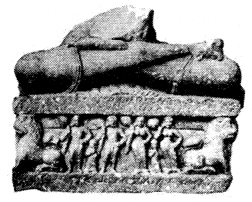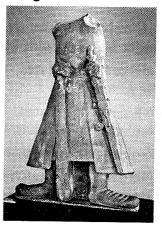Do you need some help in preparing for your upcoming Class 12 History exam? We’ve compiled a list of MCQ questions on Kings, Farmers and Towns Class 12 MCQs Questions with Answers to get you started with the subject. You can download NCERT MCQ Questions for Class 12 History Chapter 2 Kings, Farmers and Towns: Early States and Economies with Answers Pdf free download, and learn how smart students prepare well ahead MCQ Questions for Class 12 History with Answers. Start your preparation with MCQ on Kings, Farmers and Towns Class 12 Objective Questions.
Kings, Farmers and Towns Class 12 MCQs Questions with Answers
Question 1.
What are big rocks kept on the burial in central and south India called?
(a) Northern Black Polished Ware
(b) Pillars
(c) Boulders
(d) Megaliths
Answer
Answer: (d) Megaliths
Question 2.
Who was Dhamma Mahamatta?
(a) Special revenue officers appointed by Ashoka for tax collection
(b) Special officers appointed by Ashoka for maintaining law and order in the kingdom
(c) Special officers appointed by Ashoka to spread the message of dhamma
(d) Special officer appointed by Ashoka to stop the spread of dhamma
Answer
Answer: (c) Special officers appointed by Ashoka to spread the message of dhamma
Question 3.
Why is the sixth century BCE often considered a major turning point in Indian history?
(a) Emergence of states, cities, and towns; Use of iron
(b) Emergence of states, cities, and towns; Dominance of Hinduism
(c) Dominance of Hinduism; Use of iron
(d) Emergence of Buddhism and Jainism, Extensive use of Copper
Answer
Answer: (a) Emergence of states, cities, and towns; Use of iron
Question 4.
Who composed the Prayag Prashasti in praise of Samudragupta?
(a) Prabhavati Gupta
(b) Harisena
(c) Kautilya
(d) Banabhatta
Answer
Answer: (b) Harisena
Question 5.
Which of the following is not one of the main features of Ashoka’s dhamma?
(a) Respect the elders and be generous to the Brahmins.
(b) Consider your religion superior to the other religions.
(c) Gahapati should respect members of the family, relatives, servants, the poor, and the slaves.
(d) Follow non-violence.
Answer
Answer: (b) Consider your religion superior to the other religions.
Question 6.
What were the guilds of the merchants and craftsmen called?
(a) Shrenis
(b) Ur
(c) Adimai
(d) Uzhavar
Answer
Answer: (a) Shrenis
Question 7.
What is James Prinsep’s contribution in the development of the Indian epigraphy?
(a) He deciphered the Brahmi script used in most of the Ashokan inscriptions.
(b) He deciphered the Kharoshthi script used in most of the Ashokan inscriptions.
(c) Both ‘a’ and ‘b’
(d) None of these
Answer
Answer: (a) He deciphered the Brahmi script used in most of the Ashokan inscriptions.
Question 8.
Ventures of which of the following traders were risky but highly profitable?
(a) Peddlers
(b) Seafarers
(c) Merchants with caravans of bullock carts and pack-animals
(d) All of the above
Answer
Answer: (b) Seafarers
Question 9.
Who issued the first coins bearing the names of rulers?
(a) Mauryas
(b) Guptas
(c) Indo-Greeks
(d) Satavahanas
Answer
Answer: (c) Indo-Greeks
Question 10.
Ashoka is mentioned by which titles in his inscriptions?
(a) Ashoka, Piyadassi
(b) Masattuvan, Ashoka
(c) Devanampiya, Piyadassi
(d) Devaputra, Piyadassi
Answer
Answer: (c) Devanampiya, Piyadassi
Question 11.
Name the languages in which the Ashokan inscriptions were written.
(a) Pali, Prakrit, and Greek
(b) Pali, Sanskrit, and Aramaic
(c) Prakrit, Aramaic, and Greek
(d) Pali, Sanskrit, and Greek
Answer
Answer: (c) Prakrit, Aramaic, and Greek
Question 12.
______ founded the Mauryan Empire in c. 321 BCE.
Answer
Answer: Chandragupta Maurya
Question 13.
Who was Harisena?
Answer
Answer: Harisena was the court poet of king Samudragupta.
Question 14.
Match the following.
| (a) Gahapati | (i) slaves |
| (b) Vellalar | (ii) ploughman |
| (c) Uzhavar | (iii) head of household |
| (d) Adimai | (iv) landowner |
Answer
Answer:
| (a) Gahapati | (iii) head of household |
| (b) Vellalar | (iv) landowner |
| (c) Uzhavar | (ii) ploughman |
| (d) Adimai | (i) slaves |
Question 15.
Who was Prabhavati Gupta?
Answer
Answer: Prabhavati Gupta was the daughter of Chandragupta II.
Question 16.
Mention any two yajnas performed by the kings during the Vedic period.
Answer
Answer: The kings performed Rajsuya yajna and Ashwamedha yajna during the Vedic period.
Question 17.
Consider the following statements regarding Magadha.
(i) Magadha was the most powerful mahajanapada.
(ii) Initially Pataliputra was the capital of Magadha and later it was shifted to Rajagriha.
(iii) Elephants were found in abundance in the forests of Magadha.
Which of the following statement(s) is/are correct?
(a) I and II
(b) II and III
(c) I and III
(d) II only
Answer
Answer: (c) I and III
Question 18.
Identify the best reason for considering King Ashoka as ‘Devanampiya’ and ‘Piyadassi’ by his subjects.
(a) Ashoka commissioned the edicts himself
(b) He adopted the title of ‘Devaputra’.
(c) Epigraphists have concluded him as devanam priya.
(d) He did well being of society through Dhamma.
Answer
Answer: (d) He did well being of society through Dhamma.
Question 19.
Identify the image and write who got it installed.

Answer
Answer: This is part of an image from Mathura. This image was installed in a shrine by a woman named Nagapiya, the wife of a goldsmith (sovanika) named Dharmaka.
Question 20.
Look at the figure given below. Identify and name the sculpture of fourth century CE related to this figure.

Answer
Answer: This is a sandstone sculpture of a Kushana King.
Question 21.
Which one of the following statements was not a justified reason for Magadha being a powerful mahajana pada?
(a) Magadha was drained by several rivers which made the land very fertile.
(b) In Magadha there were rich deposits of iron ore.
(c) Pataliputra, the capital of Magadha, was fortified.
(d) Magadha was ruled by powerful kings.
Answer
Answer: (c) Pataliputra, the capital of Magadha, was fortified.
Question 22.
Given below are two statements, one labelled as Assertion (A) and the other labelled as Reason (R):
Assertion (A): There are limits to what epigraphy can reveal.
Reason (R): It is not always easy to be sure about the exact meaning of the words used in inscriptions.
(a) Both (A) and (R) are correct and (R) is the correct explanation of (A).
(b) Both (A) and (R) are correct and (R) is not the correct explanation of (A).
(c) (A) is correct but (R) is not correct.
(d) (R) is correct but (A) is not correct.
Answer
Answer: (a) Both (A) and (R) are correct and (R) is the correct explanation of (A).
Question 23.
Who was the author of the book ‘Arthashastra’?
Answer
Answer: Kautilya
We hope you found this CBSE Class 12 History Kings, Farmers and Towns MCQs Multiple Choice Questions with Answers helpful. If you have any questions about NCERT MCQ Questions for Class 12 History Chapter 2 Kings, Farmers and Towns: Early States and Economies with Answers Pdf free download, please share them in the comment box below and we will get back to you at the earliest possible time.